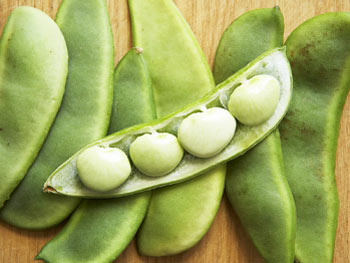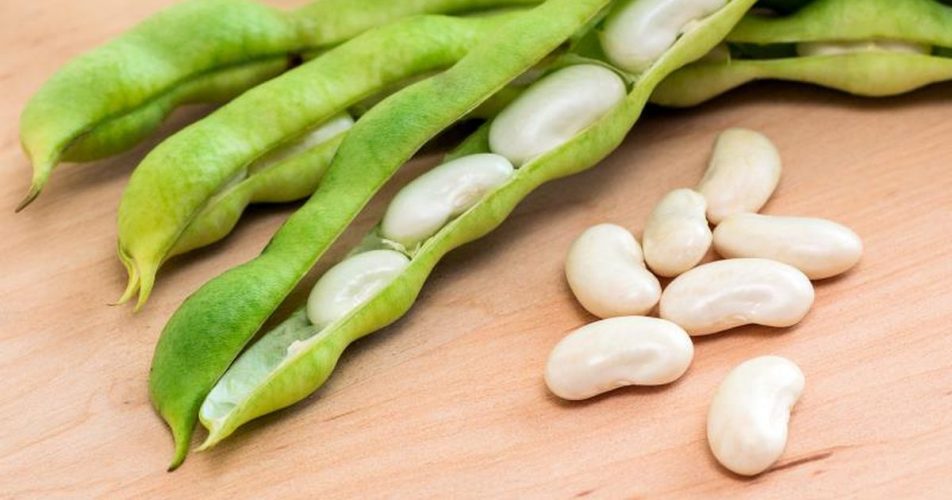10. Lima beans

Lima beans is sometimes called “butter beans” because of their starchy yet buttery texture, lima beans have a delicate flavor that complements a wide variety of dishes. Although fresh lima beans are often difficult to find, they are worth looking for in the summer and fall when they are in season. Dried and canned lima beans are available throughout the year.
The pod of the lima bean is flat, oblong and slightly curved, averaging about three inches in length. Within the pod are the two to four flat kidney-shaped seeds that we call lima beans. The seeds are generally cream or green in color, although certain varieties feature colors such as white, red, purple, brown or black.
Lima beans are an excellent source of the trace mineral, molybdenum, an integral component of the enzyme sulfite oxidase, which is responsible for detoxifying sulfites. Sulfites are a type of preservative commonly added to prepared foods like delicatessen salads and salad bars. Persons who are sensitive to sulfites in these foods may experience rapid heartbeat, headache or disorientation if sulfites are unwittingly consumed. If you have ever reacted to sulfites, it may be because your molybdenum stores are insufficient to detoxify them. A cup of lima beans will give you 86.5% of the daily value for this helpful trace mineral.
As lima beans are most often associated with succotash, a traditional Native American dish that combines this delicious bean with corn, many people think that they are native to the United States. Yet, one of lima beans’ proposed places of origin, the place where the early European explorers were thought to have first discovered them, is actually reflected in its name “Lima,” the capital of the South American country of Peru.
While there are many varieties of lima beans, the ones that are most popular in the U.S. are the Fordhook, commonly known as the butterbean, and the baby lima bean. The pod of the lima bean is flat, oblong and slightly curved, averaging about three inches in length. Within the pod reside two to four flat kidney-shaped seeds that are what we generally refer to as lima beans. The seeds are generally cream or green in color, although certain varieties feature colors such as white, red, purple, brown or black. Lima beans feature a starchy, potato-like taste and a grainy, yet slightly buttery, texture.
The scientific name for lima beans is Phaseolus lunatus.
Although lima beans have been cultivated in Peru for more than 7,000 years, historians are unsure whether they originated there or in Guatemala. Soon after Columbus’ discovery of America, Spanish explorers noticed different varieties of lima beans growing throughout the South America, Central America and the Caribbean. They introduced them to Europe and Asia, while the Portuguese explorers introduced lima beans into Africa. Since lima beans can withstand humid tropical weather better than most beans, they have become an important crop in areas of Africa and Asia. Lima beans were introduced into the United States in the 19th century with the majority of domestic commercial production centered in California.
Lima Beans and Purines
Purines are naturally-occurring substances found in plants, animals, and humans. In some individuals who are susceptible to purine-related problems, excessive intake of these substances can cause health problems. Since purines can be broken down to form uric acid, excess accumulation of purines in the body can lead to excess accumulation of uric acid. The health condition called “gout” and the formation of kidney stones from uric acid are two examples of uric acid-related problems that can be related to excessive intake of purine-containing foods. Yet, recent research has suggested that purines from meat and fish increase risk of gout, while purines from plant foods fail to change the risk.
Beans and other legumes are among the most nutritionally valuable vegetable foods. The seeds of beans are high in protein, complex carbohydrates, dietary fiber and many minerals, while low in fat and cholesterol. But they also contain a protein that can be toxic in sufficiently high concentrations if the beans are eaten raw. Kidney beans in particular contain enough of this toxin to cause acute symptoms, even if only a few raw beans are consumed.
The toxin is named phytohemagglutinin (PHA), a member of a very common class of proteins called lectins. Lectins are glycoproteins that are present in a wide variety commonly-consumed plant foods, particularly in the seeds. In most cases, they are not harmful and possibly beneficial, but some lectins are known to be toxic. One of the most dangerous poisons known, ricin, is a lectin derived from the seeds of the castor bean Ricinus communis (not a true bean and totally unrelated to the legume family Fabaceae); this is not, however, the same lectin found in beans and other legumes.
PHA is known to be an insecticide, and plants probably developed it to keep their seeds from being destroyed by pests. In humans and other susceptible mammals (those of us without compound stomachs) PHA attacks and disables the epithelial cells lining the intestine. The body reacts to the threat by emptying the entire digestive tract as rapidly and completely as possible, to rid itself of the toxic substance. This is accomplished by means of severe vomiting and diarrhea. Usually, the reaction subsides without the need for medical intervention after several miserable hours, though some persons may require IV replacement of fluids because of dehydration. But because food poisoning can come from many different sources, some of them fatal, seeking medical help is advisable when its symptoms occur.
This reaction to kidney beans is not very common because the beans are not often eaten raw. They are usually dried and require several hours of cooking before they are soft enough to eat. PHA in beans is deactivated and reduced to safe levels by as little as ten minutes of boiling. Other means of heating are less effective and may actually increase the level of PHA, as will heating below the boiling point. For this reason, such foods as chili should not be made with kidney beans in a slow cooker at the low setting without first boiling the beans.

For the safest results in cooking dried kidney beans, they should first be soaked for several hours, the soaking water discarded, then brought to the boil in fresh water and cooked for at least ten minutes.
Red kidney beans (Phaseolus vulgaris) have by far the highest concentrations of PHA. The white variety known as cannellini has only about a third of the level of the red kidney beans, but still enough to cause problems if not properly cooked. Kidney beans should never be sprouted for use in salads, and it is not likely that stir-frying kidney bean sprouts is safe, either. The presence of PHA is not, however, limited to beans of the species P vulgaris. It has also been found in significant levels in fava beans (Vicia faba).
Lima beans (Phaseolus lunatus) can also be quite dangerous when consumed raw, but in this case the culprit is a different toxin altogether: linamarin, a cyanogenic glucoside. This is the same toxic substance found in cassava root.
Individuals vary in their sensitivity to PHA, so it is probably a good idea when cooking to treat all dried beans as if they were kidney beans, and to cook fresh mature beans (shellie beans) at least long enough to deactivate the toxin. Gardeners, in particular, should be a aware of the potential dangers of raw beans if they like to “graze” in their gardens, eating the fresh raw seeds directly from the shell. The level of PHA in all varieties is not known.
Green beans (snap beans) are a questionable matter. Many people do like to eat young green beans raw, and overcooking green beans until mushy is widely regarded as a sin against the vegetable. I can find no clear evidence that raw green beans have PHA levels high enough to make them unsafe for most of the population. It should be noted that the level of PHA is highest in seeds, and green beans are usually consumed for the sake of the green fleshy pod, at a stage when the seeds are only beginning to develop. And they do taste so good that I’m likely to take the chance.
Lima beans have to be very well cooked before they are eaten because the raw beans contain a product called limarin. Just a handful can make someone violently ill so always ensure they have been cooked at least 10 minutes and never, ever put them in salads raw. Cooking renders them harmless and gives you lots of good nutrition.
Disclaimer
The Content is not intended to be a substitute for professional medical advice, diagnosis, or treatment. Always seek the advice of your physician or other qualified health provider with any questions you may have regarding a medical condition.